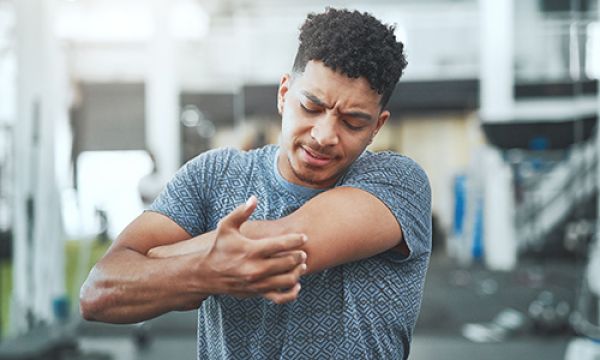
Four Common Overuse Injuries: Tennis Elbow, Golfer’s Elbow, Jumper’s Knee, Achilles Tendonitis

with Andy Harcourt, MD
The human body has remarkable capabilities. Far from a static system, the body is constantly changing and adapting to the ways that you choose to move. Through exercise and activity, we can build a stronger and more flexible body in a process known as “remodeling,” which simply means the breakdown and buildup of tissue.
But sometimes in our devotion to the sports and hobbies we love, we may stretch our capabilities too far and too fast. What happens when the repeated stress on your body causes the breakdown of tissue to happen faster than the buildup? That’s when you have an overuse injury.
What are the most common overuse injuries?
According to Dr. Andy Harcourt, an expert on non-surgical sports medicine at Baldwin Bone and Joint, four of the most common overuse injuries he sees involve the tendons. You might know them by their colloquial names:
- Tennis elbow (lateral epicondylitis) – pain on the outside of the upper arm near the elbow
- Golfer’s elbow (medial epicondylitis) – pain on the inside of your elbow
- Jumper’s knee (patellar tendonitis) – pain in the front of your knee
- Achilles tendonitis – pain in the ankle and legs
“Tendons are tissues that connect muscle to bone, and they are very susceptible to overuse,” Dr. Harcourt said. “Tendonitis, or the inflammation of the tendon, starts as pain around the areas where the tendon is inflamed. Activities that we enjoy may continue to irritate the tendon. The tissues continue to break down and the body will come in and try to repair it. As the process continues, the body will eventually stop trying to heal the tendon. Scar tissues may build up inside the tendon, and you will now have a much more serious condition called tendonosis.”
Dr. Harcourt emphasized that these conditions are not easily remedied with self-care and rest, adding that it is important to catch tendonitis early—as it can develop into a more aggressive medical problem after just six weeks. He recommends two treatments for overuse injuries.
What are the recommended treatments for overuse injuries?
Physical therapy – The goal of physical therapy is to modify the activity that is occurring and to make some smart changes to your routine. For many people suffering from overuse injuries, physical therapy alone is a sufficient treatment. In addition to activity modification, physical therapists may use therapeutic modalities such as ultrasounds or friction massage to stimulate and relax the tissue. “The body wants to return to normal and these therapies will encourage the tendon to repair itself,” Dr. Harcourt explained.
Injections – If physical therapy is not enough to treat the overuse injury at hand, injections of biologics are another promising therapy for the patient to consider. For this treatment, the physician will inject either platelet-rich plasma (PCP) extracted from the patient’s blood or stem cells taken from the patient’s bone marrow into the affected area. These biological agents will encourage the renewal of the tissue that has failed to heal. “We’ve seen tremendous success with orthobiologic injections and stem cell therapies,” Dr. Harcourt said. “We have had patients that were candidates for surgery who were healed – through injections – without undergoing surgery.”
A member of the American Medical Society for Sports Medicine, Dr. Andy Harcourt is a fellowship-trained physician in non-surgical sports medicine and an expert in treating medical issues affecting athletic performance. If you think you may have an overuse injury, don’t wait until it progresses further to get the right treatment. To find out more about your condition and to learn about the treatments available, call (251) 625-2663 to schedule a medical consultation with Dr. Andy Harcourt or another expert at the Sports Medicine Center at Baldwin Bone and Joint.